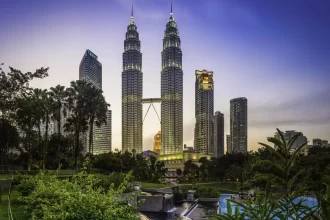June 30, Kuala Lumpur — A new chapter in cross-border connection has begun. In a moment filled with pride and promise, Malaysia and Singapore unveiled the very first Rapid Transit System (RTS) Link train today—marking a significant step forward in a project that will soon bring two nations even closer together.
Standing tall at 76.5 metres, this sleek, driverless four-car train is more than just a machine; it’s a symbol of innovation, regional partnership, and a better, faster future for daily commuters traveling between Johor Baru and Singapore.
At the heart of the celebration, held at the Singapore Rail Test Centre (SRTC) in Tuas, were dignitaries from both nations. Among them, Singapore’s Acting Transport Minister Jeffrey Siow, Malaysia’s Transport Minister Anthony Loke, and Johor’s Mentri Besar Datuk Onn Hafiz Ghazi witnessed this historic moment.
“This isn’t just a train. It’s the future of how we move, how we connect, and how we grow together,” said Datuk Khairil Anwar Ahmad, chairman of RTS Operations (RTSO), the joint venture between Singapore’s SMRT and Malaysia’s Prasarana.
Currently, 56% of the system is already in place—tracks are being laid, power systems installed, and the physical link is taking shape. By the end of July, track installation is expected to be completed.
Built by China’s CRRC Zhuzhou Locomotive, each RTS Link train can carry up to 1,087 passengers, with thoughtful features including accessible seating, space for wheelchairs and strollers, and even hearing loops for the hearing-impaired—marking a first for rail travel in both countries.
Safety hasn’t been overlooked. Emergency buttons, accessible exits, smoke and fire detectors, and windows that open for ventilation are all part of the design.
Testing begins in July at the S$800 million SRTC facility, with trial runs continuing through late 2025. Then, full service simulation trials will take place between Woodlands North and Bukit Chagar through to 2026.
Meanwhile, four more trains are currently being assembled in Batu Gajah, Perak, and the rest will follow. Once completed, they’ll be sent to Johor Baru’s Wadi Hana depot for final testing.
By 2026, when the RTS Link officially opens, the trains will be running at speeds of up to 80km/h, ferrying 10,000 people per hour in each direction over the 4km stretch—cutting through congestion, time, and borders.
More than just steel and circuits, this train is about people. About making daily life easier, more efficient, and more connected. As both nations look ahead, this project is proof that progress moves fastest when it moves together.








